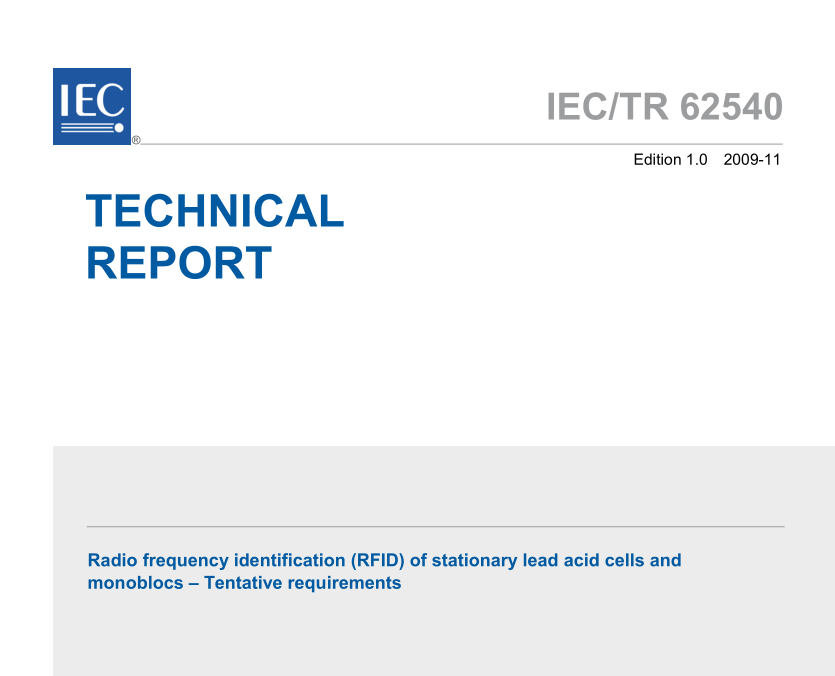IEC TR 62540:2009 pdfダウンロード

IEC TR 62540:2009 pdfダウンロード Radio frequency identification (RFID) of stationary lead acid cells and monoblocs – Tentative requirements
Scope
IEC/TR 62540, which i a technical report, applies to all stationary lead-acid cells andmonobloc batteries for float charge applications (i.e. permanently connected to a load and toa d.c. power supply), in a static location (i.e. not generally intended to be moved from place toplace) and incorporated into stationary equipment or installed in battery rooms for use intelecom, uninterruptible power supply (UPS), utility switching, emergency power or similarapplications. These batteries are covered by lEC 60896-11, EC 60896-21 and IEC 60896-22
The objective of this technical report is to assist the supplier and user of radio frequencyidentification devices (RFID) in the understanding of the requirements for performancedurability, data content and structure, the write/read capability of such devices, and to providequidance so that the RFlD tag on the battery will result in meeting the needs of a particularindustry application and operational condition.
This technical report does not directly apply to lead-acid cells and batteries used for vehicleengine starting applications (lEC 60095 series), solar photovoltaic applications (IEC 61427)or general purpose applications (IEC 61056 series) but nevertheless can also be the base otstandardization activities for these types of lead acid batteries.
2 Terms and definitions
For the purposes of this document, the following terms and definitions apply.
2.1
ambient temperaturetemperature of the medium in the immediate vicinity of a cell or battery
[IEC 60050-826:2004,826-10-03,modified]
2.2
ampere-hourquantity of electricity or a capacity of a battery obtained by integrating the discharge currentin ampere with respect to time in hours
NOTE One ampere-hour equals 3 600 coulombs.
2.3
secondary batterytwo or more secondary cells connected together and used as a sourc of electrical energy[IEC 60050-811:1991,811-20-02,modified]
2.4
monobloc batterysecondary battery in which the plate packs are fitted in a multi-compartment container
2.5
floating battery
secondary battery whose terminals are permanently connected to a source of constantvoltage sufficient to maintain the battery approximately fully charged, intended to supply acircuit,if the normal supply is temporarily interrupted
[IEC 60050-482:2004,482-05-35,modified]
2.6
battery capacityquantity of electricity or electrical charge which a fully charged battery can deliver underspecified conditions
NOTE The Sl unit for electric charge is the coulomb (1 C = 1 As) but in practice, battery capacity is expressed inampere-hours(Ah).
2.7
charge
operation during which secondary battery receives from an external circuit electrical energywhich is converted into chemical energy
NOTE A charge is defined by its maximum voltage, current and duration.
2.8cell
assembly of electrodes and electrolyte, which constitutes the basic unit of a secondary battery
[IEC60050-482:2004,482-01-01,modified]
2.9
electrochemical cell
electrochemical system capable of storing in chemical form the electric energy received andwhich can give it back by reconversion,i.e.a secondary cell
IEC 60050-811:1991,811-20-01,modified]
2.10
secondary cellassembly of electrodes and electrolyte which constitutes the basic unit of a secondary battery
2.11
valve-requlated cell
secondary cell which is coded under normal conditions but which has an arrangement, whichallows the escape of gas if the internal pressure exceeds a predetermined value
NOTE 1 The cell cannot normally receive the addition of electrolyte
NOTE 2 Such cells have an immobilized electrolyte to prevent spillage and allow for oxygen recombination on thenegative electrode.
- Previous:IEC TR 62517:2009 pdfダウンロード
- Next:IEC TR 62544:2011 pdfダウンロード